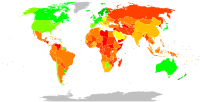
Photo from wikipedia
BACKGROUND & AIMS Hepatic encephalopathy (HE) is a syndrome of decreased vigilance and has been associated with impaired driving ability. The aim of this study was to evaluate the psychomotor… Click to show full abstract
BACKGROUND & AIMS Hepatic encephalopathy (HE) is a syndrome of decreased vigilance and has been associated with impaired driving ability. The aim of this study was to evaluate the psychomotor vigilance task (PVT), which is used to assess both vigilance and driving ability, in a group of patients with cirrhosis and varying degrees of HE. METHODS A total of 145 patients (120 males, 59 ± 10 years, model for end-stage liver disease [MELD] score 13 ± 5) underwent the PVT; a subgroup of 117 completed a driving questionnaire and a subgroup of 106 underwent the psychometric hepatic encephalopathy score (PHES) and an electroencephalogram (EEG), based on which, plus a clinical evaluation, they were classed as being unimpaired (n = 51), or as having minimal (n = 35), or mild overt HE (n = 20). All patients were followed up for an average of 13 ± 5 months in relation to the occurrence of accidents and/or traffic offences, HE-related hospitalisations and death. Sixty-six healthy volunteers evenly distributed by sex, age and education served as a reference cohort for the PVT. RESULTS Patients showed worse PVT performance compared with healthy volunteers, and PVT indices significantly correlated with MELD, ammonia levels, PHES and the EEG results. Significant associations were observed between neuropsychiatric performance/PVT indices and licence/driving status. PVT, PHES and EEG results all predicted HE-related hospitalisations and/or death over the follow-up period; none predicted accidents or traffic offences. However, individuals with the slowest reaction times and most lapses on the PVT were often not driving despite having a licence. When patients who had stopped driving for HE-related reasons (n = 6) were modelled as having an accident or fine over the subsequent 6 and 12 months, PVT was a predictor of accidents and traffic offences, even after correction for MELD and age. CONCLUSIONS The PVT is worthy of further study for the purposes of both HE and driving ability assessment. LAY SUMMARY Hepatic encephalopathy (HE) is a complication of advanced liver disease that can manifest as excessive sleepiness. Some patients with HE have been shown to have difficulty driving. Herein, we used a test called the Psychomotor Vigilance Task (PVT), which measures sleepiness and can also be used to assess driving competence. We showed that PVT performance is fairly stable in healthy individuals. We also showed that PVT performance parallels performance in tests which are commonly used in cirrhotic patients to measure HE. We suggest that this test is helpful in quantifying HE and identifying dangerous drivers among patients with cirrhosis.
Journal Title: Journal of hepatology
Year Published: 2019
Link to full text (if available)
Share on Social Media: Sign Up to like & get
recommendations!